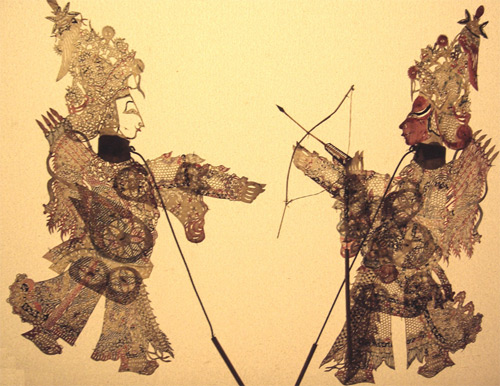 Go Back Go Back
 Print Page Print Page
A Brief History of the Video Projector
A Brief History of the Video Projector - Part 1 of 3
Emerging From The Shadows

Chinese Shadow Play Figures, Two warriors; Qianlong Set; approx. 1780, Photographer: Dr. Meierhofer, 2006
From the first person who played with shadow puppets in the firelight, to the first ancient Egyptian passion play, we have always sought more and better forms of entertainment. We’ve used entertainment to communicate with the gods, and used it to gaze deep within ourselves, to define ourselves. The audience has always pushed the entertainer to greater efforts, rewarding them with laughter, tears, and more recently great big piles of money.
The modern entertainment industry is an enormous beast, particularly when you include the television and electronic manufacturers who bring the experience into our homes, cars, pockets, etc. Fortunes are made and lost in the pursuit of the latest and greatest forms of entertainment. We’ve become choosy in how we experience entertainment, looking for a picture and sound experience that’s bigger than life.
We weren’t always this sophisticated. Puppetry dates back almost 30,000 years, and would have been anything but sophisticated in modern terms. What hasn’t changed is the relationship between the entertainer and his or her audience. Humanity has always had a great need to be entertained. As human society has advanced, our expectations of entertainment have advanced as well. As a result, the entertainer is by necessity an innovator, striving to further captivate the audience through ever advancing, more engrossing means. The audience becomes the entertainers driving force, demanding more and better means of gratification, and the entertainer, fulfilling the innovator’s role, obliges.
As a result, the history of film, projection, television, reads like a snowball of innovation and change. Fortunes were won and lost, empires established and lost, but through it all was the driving need to entertain, to monetize an audience that always wanted more. It was this driving ambition that drove the innovators to push the very limits of available technology. Some failed, but others literally changed history.
Fast Forward 29,990-ish years to...

The current state of the art technology is in flux. 3D is battling HD. DVDs have finally given way to Blu-Rays. More or less. Sound comes in 6 channels now, sometimes seven, sometimes eight, sometimes more… watching a movie used to be simple. Now we’re all playing the numbers game when shopping for entertainment. Our digital age has lubed the gears of change and it doesn’t look like it’s about to stop or even slow down any time soon.
So when you unbox your brand new 3D JVC DILA 1080P HD Home Theater Projector you’re part of a long chain of enthusiasts demanding better entertainment. In fact, there is a direct connection, an established bloodline, between this state of the art video projector and simple table top moving picture devices of the 1800’s. These first attempts at a moving picture device were devilishly clever, and astonishingly simple at the same time. These old moving picture devices had the craziest names, as people seemingly struggled to grasp the basic concepts. So here’s where we start, with a look at some of the oldest motion picture devices. These were originally mechanical parlor tricks, not really intended to entertain a family or larger group. Among the first devices designed to entertain was a strange mechanical device called a Phenakistoscope, or “Life Wheel”. There were a lot of steps in between, but today’s high tech units work on similar principals to the first Phenakistoscope in the 1830’s.
Spinning Wheels
The first moving picture devices weren’t televisions or projectors at all. They were mechanical curiosities that featured spinning paintings or drawings, and a viewing port of some sort that allowed only one image to be viewed for a very short period of time. The first of these devices was a simple device called the Phenakistoscope
Phenakistoscope
The Phenakistoscope was built in 1832. It was also known as the “Life Wheel”. Images of, in one version, a dancing couple are painted around the edge of a spinning wheel. The images are painted sequentially, conveying motion. Peer through one of the slits, and presto - the couple dances, for instance. Sure enough, the couple appears to dance. Motion was jerky and the drawings were crude, but it worked.
Go to Next Page- The Zoetrope
|

